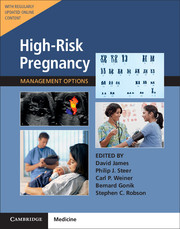Book contents
- Frontmatter
- Contents
- List of Contributors
- Preface
- Section 1 Prepregnancy Problems
- Section 2 Early Prenatal Problems
- Section 3 Late Prenatal – Fetal Problems
- Section 4 Problems Associated with Infection
- Section 5 Late Pregnancy – Maternal Problems
- 30 Substance Misuse in Pregnancy
- 31 Medication in Pregnancy
- 32 Hypertension in Pregnancy
- 33 Cardiac Disease in Pregnancy
- 34 Respiratory Disease in Pregnancy
- 35 Anemia and White Blood Cell Disorders in Pregnancy
- 36 Hematological Malignancies in Pregnancy
- 37 Thrombocytopenia and Bleeding Disorders in Pregnancy
- 38 Disorders of Coagulation in Pregnancy
- 39 Autoimmune Disease in Pregnancy
- 40 Diabetes in Pregnancy
- 41 Thyroid Disease in Pregnancy
- 42 Pituitary and Adrenal Disease in Pregnancy
- 43 Gastrointestinal and Liver Diseases in Pregnancy
- 44 Neurologic Complications in Pregnancy
- 45 Renal Disorders in Pregnancy
- 46 Spine and Joint Disorders in Pregnancy
- 47 Skin Disease in Pregnancy
- 48 Malignant Disease in Pregnancy
- 49 Pregnancy After Transplantation
- 50 Trauma in Pregnancy
- 51 Mental Health Disorders in Pregnancy
- Section 6 Late Prenatal – Obstetric Problems
- Section 7 Postnatal Problems
- Section 8 Normal Values
- Index
50 - Trauma in Pregnancy
from Section 5 - Late Pregnancy – Maternal Problems
- Frontmatter
- Contents
- List of Contributors
- Preface
- Section 1 Prepregnancy Problems
- Section 2 Early Prenatal Problems
- Section 3 Late Prenatal – Fetal Problems
- Section 4 Problems Associated with Infection
- Section 5 Late Pregnancy – Maternal Problems
- 30 Substance Misuse in Pregnancy
- 31 Medication in Pregnancy
- 32 Hypertension in Pregnancy
- 33 Cardiac Disease in Pregnancy
- 34 Respiratory Disease in Pregnancy
- 35 Anemia and White Blood Cell Disorders in Pregnancy
- 36 Hematological Malignancies in Pregnancy
- 37 Thrombocytopenia and Bleeding Disorders in Pregnancy
- 38 Disorders of Coagulation in Pregnancy
- 39 Autoimmune Disease in Pregnancy
- 40 Diabetes in Pregnancy
- 41 Thyroid Disease in Pregnancy
- 42 Pituitary and Adrenal Disease in Pregnancy
- 43 Gastrointestinal and Liver Diseases in Pregnancy
- 44 Neurologic Complications in Pregnancy
- 45 Renal Disorders in Pregnancy
- 46 Spine and Joint Disorders in Pregnancy
- 47 Skin Disease in Pregnancy
- 48 Malignant Disease in Pregnancy
- 49 Pregnancy After Transplantation
- 50 Trauma in Pregnancy
- 51 Mental Health Disorders in Pregnancy
- Section 6 Late Prenatal – Obstetric Problems
- Section 7 Postnatal Problems
- Section 8 Normal Values
- Index
Summary
Incidence and Risks
Trauma occurs in 6–7% of all pregnancies and is the leading cause of nonobstetric maternal death. In the United States in 2002, almost 17,000 pregnant women sustained an injury requiring hospitalization, and nearly half of those women were under 25 years old. For trauma admissions not resulting in delivery, motor vehicle crashes (MVCs) were the most common cause, followed by falls; the reverse is seen with patients requiring delivery at the time of trauma admission. Poisoning, overexertion injuries, assault, and penetrating trauma are also important contributors. MVCs occur with equal frequency across trimesters, whereas falls are most frequent between 20 and 30 weeks, and trauma secondary to abuse and interpersonal violence increases with advancing gestation. The cost of an admission for a pregnant trauma patient is higher than for a nonpregnant trauma patient with the same injury severity.
Most injuries during pregnancy are minor, but 2–8% of victims have a life-threatening injury and require admission to an intensive care unit. Maternal mortality from trauma approximates 10%, but it is the same as nonpregnant patients when matched for injury severity. Trauma places the mother and fetus at increased risk, and fetal loss occurs in at least 40% of critically injured gravidas. High Injury Severity Score (ISS) and Glasgow Coma Scale (GCS) scores, increasing fluid requirement during resuscitation, and maternal acidosis and hypoxia appear to predict an increase in fetal loss.
Domestic violence is an important cause of trauma in pregnancy, affecting up to 50% of pregnancies in low-income populations. A comprehensive review published by the World Health Organization in 2013 reported that “the global prevalence of physical and/or sexual intimate partner violence among all ever-partnered women was 30%.” A high index of suspicion should be present for any pregnant woman presenting after a traumatic injury.
Women injured during pregnancy but not requiring delivery at the time of their injury nevertheless appear to be at increased risk for adverse outcome. An increased risk for preterm delivery, low birth weight, and abruption has been reported when injured pregnant women are followed for the duration of their pregnancy. Several mechanisms have been proposed. Trauma may be a marker for lifestyle risks that adversely affect pregnancy outcomes. Alternatively, placental injury at the time of the traumatic event may result in uteroplacental insufficiency and/or chronic abruption.
- Type
- Chapter
- Information
- High-Risk Pregnancy: Management OptionsFive-Year Institutional Subscription with Online Updates, pp. 1470 - 1500Publisher: Cambridge University PressFirst published in: 2017



